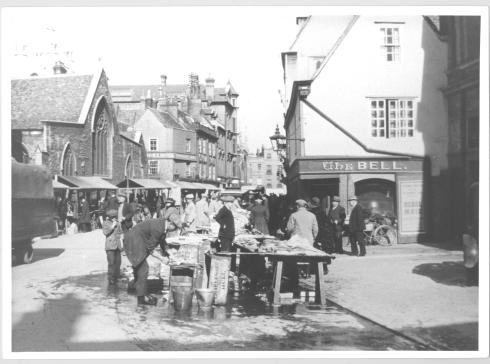Peas Hill – ‘A fishy tale’
The past five years have seen the Peas Hill area of Cambridge turn into a popular foodie quarter. First Jamie’s Italian, then CAU, Aromi, Zizi’s and new kid on the block The Pint Shop, opening its doors in November.
Yet food and Peas Hill have had a close connection for many centuries
The street housed the fish market from 1572, when it was moved from the Market Square. The street’s name deriving from ‘piscaria’, the Latin for fish market.
The fish market was important, and dealt in a great variety of fish: salmon, Colchester oysters, as well as mackerel, herrings, sprats, eels, jacks, and other fresh-water fish and thrived until the 1930s.
However, that was not the end of fish selling in Peas Hill. The Sennitt family, a well-known Cambridge butchers, poulterers and fishmongers, had a shop in Peas Hill selling wet fish, pheasants, partridges, pigeons and rabbits in the 1950s and 1960s. Followed by a branch of MacFisheries was still trading in the 1970s.
Of course Peas Hill is not a hill, but rising 50 foot above the rest of the town it was selected, along with Market Hill, as a good location for a market because it was higher and drier than the rest of a damp and generally low-lying town.
Being in a central part of the medieval town the Peas Hill area is steeped in history.
An Augustine Friary once dominated the landscape. Bounded by what are now Wheeler Street, Bene’t Street and Free School Lane. The Friary played an important part of town history for over 250 years. Founded in 1290 and suppressed in 1538. A casualty of the dissolution of the monasteries under Henry VIII.
The Perse Boys School, originally called the Free School, was founded within the site in 1615. Hence Free School Lane. The Whipple Museum is partly housed in the large hall of the original Jacobean Free School. The school moved to new premises in 1890.
In 1760 the Vice Master of Trinity bought up much of the Friary land presenting it to the University as a Botanic Garden. The Gardens were to remain there until they moved to their current home in 1831 and the site was used to build University Departments and took on the name of the ‘New Museum’s Site’.
In the 1800s Mayor Mortlock, a banker, and 13 times Mayor of Cambridge, bought land facing Peas Hill. He went on to build what was until recently Barclays Bank, in Bene’t Street, now Zizi’s.
In 1807 Edward Gillam, also a banker, leased land from Mayor Mortlock and built 10 Peas Hill, a find merchants house. Soon to open its doors as The Pint Shop. He went on, rather contentiously, given its proximity to Mortlocks Bank, to open a room in his house to found The Cambridge Bank.
However, Edwards’s banking aspirations were not realized as he died in 1815.
Various local bankers then leased the building, although not run as a bank and a variety of people rented the property.
In 1912 Francis and Co Solicitor a renowned local law firm leased the building and stayed there until 1986 when they merged with Mills and Reeve.
The Cambridge Arts Theatre, founded in 1936 by John Maynard Keynes, has a major presence in the street and was once ‘the’ place to have afternoon tea looking over the rooftops of Cambridge.
However, one of the street’s most unusual features cannot be seen: its extensive cellars running beneath the street, covering a quarter of an acre. Two of the tunnels are 100yds long. They were once used as wine vaults and during the Second World War as an air-raid shelter. Another blog piece will cover this secret history.



